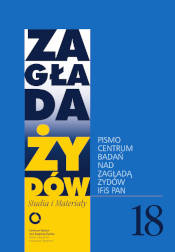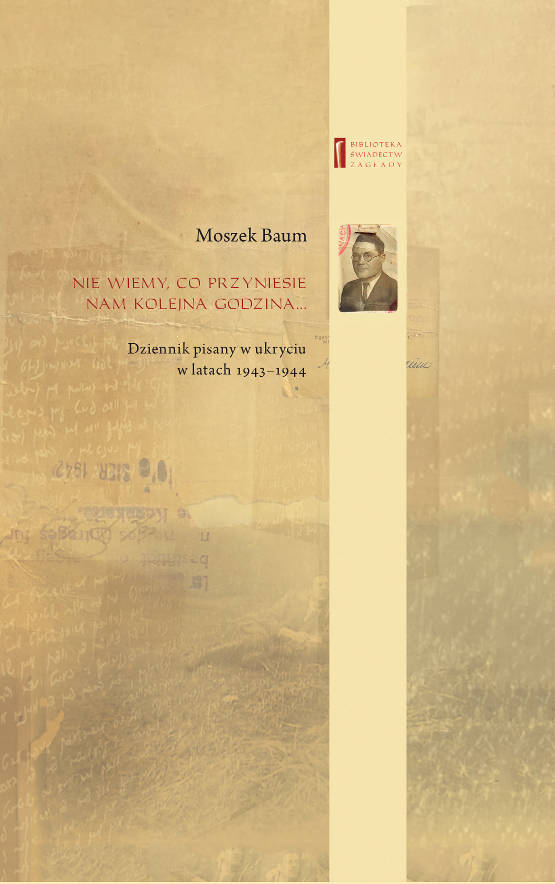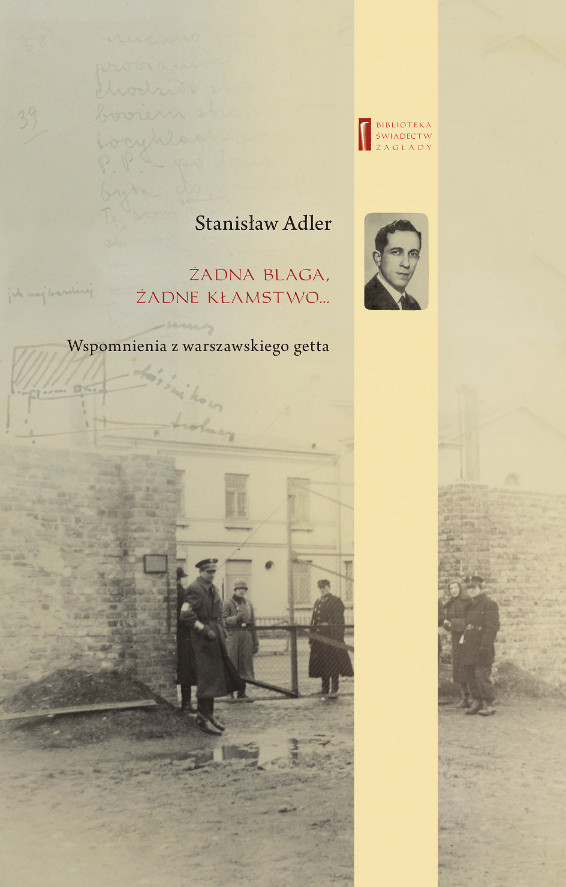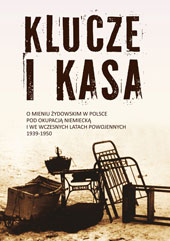Menu
- Main Page
- About us
- Research
- Publications
- Links
- Contact
- Archiwum
- Holocaust. Studies and Materials
the Center's Journal - NIGHT WITHOUT AND END - »FAILED CORRECTION«
News
Invitation to submit proposals to the >Materials
Invitation to submit proposals to the "Materials" section for the 20th anniversary issue of our journal
#StandWithAlex
AlexDancyg - a friend and acquaintance of so many of us, was kidnapped by Hamas on October 7 with dozens of other residents of the Nir Oz kibbutz in the Negev Desert, located just a few kilometers from the Gaza Strip. We are waiting here for you Alex and we are with you!
We mourn Nechama Tec
We mourn with sadness Prof. Nechama Tec, who was with the Center for many years. A member of the Scientific Council of the annual "Holocaust Studies and Materials".
Statement against attack on Prof. Jan Grabowski's lecture
We strongly condemn the direct attack by MP Grzegorz Braun and the rupture of Prof. Jan Grabowski's lecture at the German Historical Institute
Tel Aviv University Honorary Doctorate for Barbara Engelking
On May 18, at 7:30 pm (polish time), Prof. Barbara Engelking will receive an honorary doctorate from Tel Aviv University awarded to her in 2021. Online streaming
NEWSLETTER
 Zagłada Żydów.
Zagłada Żydów.
Studia i Materiały
nr 18, R. 2022
Warszawa 2022
 PAMIĘTNIK
PAMIĘTNIK
Kalman Rotgeber
oprac. Aleksandra Bańkowska, wstęp Jacek Leociak
Warszawa 2021
Zagłada Żydów.
Studia i Materiały
nr 17, R. 2021
Warszawa 2021
 NIE WIEMY CO PRZYNIESIE NAM KOLEJNA GODZINA ...
NIE WIEMY CO PRZYNIESIE NAM KOLEJNA GODZINA ...
Dziennik pisany w ukryciu w latach 1943-1944
Moszek Baum, oprac. Barbara Engelking, tłum. z jidysz Monika Polit
Warszawa 2020
Zagłada Żydów.
Studia i Materiały
nr 16, R. 2020
Warszawa 2020
.jpg) Aryjskiego Żyda wspomnienia, łzy i myśli
Aryjskiego Żyda wspomnienia, łzy i myśli
Zapiski z okupacyjnej Warszawy
Sewek Okonowski, oprac. Marta Janczewska
 PISZĄCY TE SŁOWA JEST PRACOWNIKIEM
PISZĄCY TE SŁOWA JEST PRACOWNIKIEM
GETTOWEJ INSTYTUCJI ...
'z Dziennika' i inne pisma z łódzkiego getta
Józef Zelkowicz, tłum. z jidysz, oprac. i wstęp. Monika Polit
Warszawa 2019
CZYTAJĄC GAZETĘ NIEMIECKĄ ...
Dziennik pisany w ukryciu w Warszawie w latach 1943-1944
Jakub Hochberg, oprac. i wstępem opatrzyła Barbara Engelking
Warszawa 2019
Zagłada Żydów.
Studia i Materiały
nr 15, R. 2019
Warszawa 2019
.jpg) Zagłada Żydów.
Zagłada Żydów.
Studia i Materiały
nr 14, R. 2018
Warszawa 2018
 DALEJ JEST NOC. Losy Żydów w wybranych powiatach okupowanej Polski
DALEJ JEST NOC. Losy Żydów w wybranych powiatach okupowanej Polski
red. i wstęp Barbara Engelking, Jan Grabowski
Warszawa 2018
 ŻADNA BLAGA, ŻADNE KŁAMSTWO ...
ŻADNA BLAGA, ŻADNE KŁAMSTWO ...
Wspomnienia z warszawskiego getta
Stanisław Adler, oprac. i wstępem opatrzyła Marta Janczewska
Warszawa 2018
 Zagłada Żydów.
Zagłada Żydów.
Studia i Materiały
nr 13, R. 2017
Warszawa 2017
 TYLEŚMY JUŻ PRZESZLI ...
TYLEŚMY JUŻ PRZESZLI ...
Dziennik pisany w bunkrze (Żółkiew 1942-1944)
Clara Kramer, oprac. i wstępem opatrzyła Anna Wylegała
Warszawa 2017
 WŚRÓD ZATRUTYCH NOŻY ...
WŚRÓD ZATRUTYCH NOŻY ...
Zapiski z getta i okupowanej Warszawy
Tadeusz Obremski, oprac. i wstępem opatrzyła Agnieszka Haska
Warszawa 2017
 PO WOJNIE, Z POMOCĄ BOŻĄ, JUŻ NIEBAWEM ...
PO WOJNIE, Z POMOCĄ BOŻĄ, JUŻ NIEBAWEM ...
Pisma Kopla i Mirki Piżyców o życiu w getcie i okupowanej Warszawie
oprac. i wstępem opatrzyła Barbara Engelking i Havi Dreifuss
Warszawa 2017
 Zagłada Żydów.
Zagłada Żydów.
Studia i Materiały
nr 12, R. 2016
Warszawa 2016
.jpg) SNY CHOCIAŻ MAMY WSPANIAŁE ...
SNY CHOCIAŻ MAMY WSPANIAŁE ...
Okupacyjne dzienniki Żydów z okolic Mińska Mazowieckiego
oprac. i wstępem opatrzyła Barbara Engelking
Warszawa 2016
 Zagłada Żydów.
Zagłada Żydów.
Studia i Materiały
nr 11, R. 2015
Warszawa 2015
 Mietek Pachter
Mietek Pachter
UMIERAĆ TEŻ TRZEBA UMIEĆ ...
oprac. B. Engelking
Warszawa 2015
 Zagłada Żydów.
Zagłada Żydów.
Studia i Materiały
nr 10, t. I-II, R. 2014
Warszawa 2015
 OCALONY Z ZAGŁADY
OCALONY Z ZAGŁADY
Wspomnienia chłopca z Sokołowa Podlaskiego
tłum. Elżbieta Olender-Dmowska
red .B. Engelking i J. Grabowski
Warszawa 2014
 ZAGŁADA ŻYDÓW. STUDIA I MATERIAŁY
ZAGŁADA ŻYDÓW. STUDIA I MATERIAŁY
vol. 9 R. 2013
Pismo Centrum Badań nad Zagładą Żydów IFiS PAN
Warszawa 2013
 ... TĘSKNOTA NACHODZI NAS JAK CIĘŻKA CHOROBA ...
... TĘSKNOTA NACHODZI NAS JAK CIĘŻKA CHOROBA ...
Korespondencja wojenna rodziny Finkelsztejnów, 1939-1941
oprac. i wstępem opatrzyła Ewa Koźmińska-Frejlak
Warszawa 2012
Raul Hilberg
PAMIĘĆ I POLITYKA. Droga historyka Zagłady
tłum. Jerzy Giebułtowski
Warszawa 2012
 Monika Polit
Monika Polit
"Moja żydowska dusza nie obawia się dnia sądu."
Mordechaj Chaim Rumkowski. Prawda i zmyślenie
Warszawa 2012
.jpg) Dariusz Libionka i Laurence Weinbaum
Dariusz Libionka i Laurence Weinbaum
Bohaterowie, hochsztaplerzy, opisywacze. Wokół Żydowskiego Związku Wojskowego
Warszawa 2011
.jpg) Zagłada Żydów.
Zagłada Żydów.
Studia i Materiały
R. 2011, nr. 7; Warszawa 2011
.jpg) Jan Grabowski
Jan Grabowski
JUDENJAGD. Polowanie na Żydów 1942.1945.
Studium dziejów pewnego powiatu
Warszawa 2011
.jpg) Stanisław Gombiński (Jan Mawult)
Stanisław Gombiński (Jan Mawult)
Wspomnienia policjanta z warszawskiego getta
oprac. i wstęp Marta Janczewska
Warszawa 2010
Holocaust Studies and Materials
Journal of the Polish Center for Holocaust Research
Warssaw 2010
.jpg) Żydów łamiących prawo należy karać śmiercią!
Żydów łamiących prawo należy karać śmiercią!
"Przestępczość" Żydów w Warszawie, 1939-1942
B. Engelking, J. Grabowski
Warszawa 2010
Zagłada Żydów.
Studia i Materiały
R. 2010, nr. 6; Warszawa 2010
Wybór źródeł do nauczania o zagładzie Żydów
Ćwiczenia ze źródłami
red. A. Skibińska, R. Szuchta
Warszawa 2010
.jpg) W Imię Boże!
W Imię Boże!
Cecylia Gruft
oprac. i wstęp Łukasz Biedka
Warszawa 2009
Zagłada Żydów.
Studia i Materiały
R. 2009, nr. 5; Warszawa 2009
.jpg) Żydzi w powstańczej Warszawie
Żydzi w powstańczej Warszawie
Barbara Engelking i Dariusz Libionka
Warszawa 2009
 Reportaże z warszawskiego getta
Reportaże z warszawskiego getta
Perec Opoczyński
Warszawa 2009
 Notatnik
Notatnik
Szmul Rozensztajn
Warszawa 2008
.jpg) Holocaust
Holocaust
Studies and Materials.
English edition
2008, vol. 1; Warsaw 2008
.jpg) Źródła do badań nad zagładą Żydów na okupowanych ziemiach polskich
Źródła do badań nad zagładą Żydów na okupowanych ziemiach polskich
Przewodnik archiwalno-bibliograficzny
Alina Skibińska, wsp. Marta Janczewska, Dariusz Libionka, Witold Mędykowski, Jacek Andrzej Młynarczyk, Jakub Petelewicz, Monika Polit
Warszawa 2007
Zagłada Żydów. Studia i Materiały
R. 2007, nr. 3; Warszawa 2007
Prowincja noc.
Życie i zagłada Żydów w dystrykcie warszawskim
Warszawa 2007
.jpg) Utajone miasto.
Utajone miasto.
Żydzi po 'aryjskiej' stronie Warszawy [1941-1944]
Gunnar S Paulsson
Kraków 2007
 Sprawcy, Ofiary, Świadkowie.
Sprawcy, Ofiary, Świadkowie.
Zagłada Żydów, 1933-1944
Raul Hilberg
Warszawa 2007
Zagłada Żydów. Studia i Materiały
R. 2006, nr. 2; Warszawa 2006
"Jestem Żydem, chcę wejść!".
Hotel Polski w Warszawie, 1943.
Agnieszka Haska
Warszawa 2006
Zagłada Żydów. Studia i Materiały
R. 2005, nr. 1; Warszawa 2005
.jpg) 'Ja tego Żyda znam!'
'Ja tego Żyda znam!'
Szantażowanie Żydów w Warszawie, 1939-1943.
Jan Grabowski
Warszawa 2004
 'Szanowny panie Gistapo!'
'Szanowny panie Gistapo!'
Donosy do władz niemieckich w Warszawie i okolichach, 1940-1941
Barbara Engelking, Warszawa 2003
aaa
 Zagłada Żydów.
Zagłada Żydów.
Studia i Materiały
nr 18, R. 2022
Warszawa 2022
 PAMIĘTNIK
PAMIĘTNIK
Kalman Rotgeber
oprac. Aleksandra Bańkowska, wstęp Jacek Leociak
Warszawa 2021
Zagłada Żydów.
Studia i Materiały
nr 17, R. 2021
Warszawa 2021
 NIE WIEMY CO PRZYNIESIE NAM KOLEJNA GODZINA ...
NIE WIEMY CO PRZYNIESIE NAM KOLEJNA GODZINA ...
Dziennik pisany w ukryciu w latach 1943-1944
Moszek Baum, oprac. Barbara Engelking, tłum. z jidysz Monika Polit
Warszawa 2020
Zagłada Żydów.
Studia i Materiały
nr 16, R. 2020
Warszawa 2020
.jpg) Aryjskiego Żyda wspomnienia, łzy i myśli
Aryjskiego Żyda wspomnienia, łzy i myśli
Zapiski z okupacyjnej Warszawy
Sewek Okonowski, oprac. Marta Janczewska
 PISZĄCY TE SŁOWA JEST PRACOWNIKIEM
PISZĄCY TE SŁOWA JEST PRACOWNIKIEM
GETTOWEJ INSTYTUCJI ...
'z Dziennika' i inne pisma z łódzkiego getta
Józef Zelkowicz, tłum. z jidysz, oprac. i wstęp. Monika Polit
Warszawa 2019
CZYTAJĄC GAZETĘ NIEMIECKĄ ...
Dziennik pisany w ukryciu w Warszawie w latach 1943-1944
Jakub Hochberg, oprac. i wstępem opatrzyła Barbara Engelking
Warszawa 2019
Zagłada Żydów.
Studia i Materiały
nr 15, R. 2019
Warszawa 2019
.jpg) Zagłada Żydów.
Zagłada Żydów.
Studia i Materiały
nr 14, R. 2018
Warszawa 2018
 DALEJ JEST NOC. Losy Żydów w wybranych powiatach okupowanej Polski
DALEJ JEST NOC. Losy Żydów w wybranych powiatach okupowanej Polski
red. i wstęp Barbara Engelking, Jan Grabowski
Warszawa 2018
 ŻADNA BLAGA, ŻADNE KŁAMSTWO ...
ŻADNA BLAGA, ŻADNE KŁAMSTWO ...
Wspomnienia z warszawskiego getta
Stanisław Adler, oprac. i wstępem opatrzyła Marta Janczewska
Warszawa 2018
 Zagłada Żydów.
Zagłada Żydów.
Studia i Materiały
nr 13, R. 2017
Warszawa 2017
 TYLEŚMY JUŻ PRZESZLI ...
TYLEŚMY JUŻ PRZESZLI ...
Dziennik pisany w bunkrze (Żółkiew 1942-1944)
Clara Kramer, oprac. i wstępem opatrzyła Anna Wylegała
Warszawa 2017
 WŚRÓD ZATRUTYCH NOŻY ...
WŚRÓD ZATRUTYCH NOŻY ...
Zapiski z getta i okupowanej Warszawy
Tadeusz Obremski, oprac. i wstępem opatrzyła Agnieszka Haska
Warszawa 2017
 PO WOJNIE, Z POMOCĄ BOŻĄ, JUŻ NIEBAWEM ...
PO WOJNIE, Z POMOCĄ BOŻĄ, JUŻ NIEBAWEM ...
Pisma Kopla i Mirki Piżyców o życiu w getcie i okupowanej Warszawie
oprac. i wstępem opatrzyła Barbara Engelking i Havi Dreifuss
Warszawa 2017
 Zagłada Żydów.
Zagłada Żydów.
Studia i Materiały
nr 12, R. 2016
Warszawa 2016
.jpg) SNY CHOCIAŻ MAMY WSPANIAŁE ...
SNY CHOCIAŻ MAMY WSPANIAŁE ...
Okupacyjne dzienniki Żydów z okolic Mińska Mazowieckiego
oprac. i wstępem opatrzyła Barbara Engelking
Warszawa 2016
 Zagłada Żydów.
Zagłada Żydów.
Studia i Materiały
nr 11, R. 2015
Warszawa 2015
 Mietek Pachter
Mietek Pachter
UMIERAĆ TEŻ TRZEBA UMIEĆ ...
oprac. B. Engelking
Warszawa 2015
 Zagłada Żydów.
Zagłada Żydów.
Studia i Materiały
nr 10, t. I-II, R. 2014
Warszawa 2015
 OCALONY Z ZAGŁADY
OCALONY Z ZAGŁADY
Wspomnienia chłopca z Sokołowa Podlaskiego
tłum. Elżbieta Olender-Dmowska
red .B. Engelking i J. Grabowski
Warszawa 2014
 ZAGŁADA ŻYDÓW. STUDIA I MATERIAŁY
ZAGŁADA ŻYDÓW. STUDIA I MATERIAŁY
vol. 9 R. 2013
Pismo Centrum Badań nad Zagładą Żydów IFiS PAN
Warszawa 2013
 ... TĘSKNOTA NACHODZI NAS JAK CIĘŻKA CHOROBA ...
... TĘSKNOTA NACHODZI NAS JAK CIĘŻKA CHOROBA ...
Korespondencja wojenna rodziny Finkelsztejnów, 1939-1941
oprac. i wstępem opatrzyła Ewa Koźmińska-Frejlak
Warszawa 2012
Raul Hilberg
PAMIĘĆ I POLITYKA. Droga historyka Zagłady
tłum. Jerzy Giebułtowski
Warszawa 2012
 Monika Polit
Monika Polit
"Moja żydowska dusza nie obawia się dnia sądu."
Mordechaj Chaim Rumkowski. Prawda i zmyślenie
Warszawa 2012
.jpg) Dariusz Libionka i Laurence Weinbaum
Dariusz Libionka i Laurence Weinbaum
Bohaterowie, hochsztaplerzy, opisywacze. Wokół Żydowskiego Związku Wojskowego
Warszawa 2011
.jpg) Zagłada Żydów.
Zagłada Żydów.
Studia i Materiały
R. 2011, nr. 7; Warszawa 2011
.jpg) Jan Grabowski
Jan Grabowski
JUDENJAGD. Polowanie na Żydów 1942.1945.
Studium dziejów pewnego powiatu
Warszawa 2011
.jpg) Stanisław Gombiński (Jan Mawult)
Stanisław Gombiński (Jan Mawult)
Wspomnienia policjanta z warszawskiego getta
oprac. i wstęp Marta Janczewska
Warszawa 2010
Holocaust Studies and Materials
Journal of the Polish Center for Holocaust Research
Warssaw 2010
.jpg) Żydów łamiących prawo należy karać śmiercią!
Żydów łamiących prawo należy karać śmiercią!
"Przestępczość" Żydów w Warszawie, 1939-1942
B. Engelking, J. Grabowski
Warszawa 2010
Zagłada Żydów.
Studia i Materiały
R. 2010, nr. 6; Warszawa 2010
Wybór źródeł do nauczania o zagładzie Żydów
Ćwiczenia ze źródłami
red. A. Skibińska, R. Szuchta
Warszawa 2010
.jpg) W Imię Boże!
W Imię Boże!
Cecylia Gruft
oprac. i wstęp Łukasz Biedka
Warszawa 2009
Zagłada Żydów.
Studia i Materiały
R. 2009, nr. 5; Warszawa 2009
.jpg) Żydzi w powstańczej Warszawie
Żydzi w powstańczej Warszawie
Barbara Engelking i Dariusz Libionka
Warszawa 2009
 Reportaże z warszawskiego getta
Reportaże z warszawskiego getta
Perec Opoczyński
Warszawa 2009
 Notatnik
Notatnik
Szmul Rozensztajn
Warszawa 2008
.jpg) Holocaust
Holocaust
Studies and Materials.
English edition
2008, vol. 1; Warsaw 2008
.jpg) Źródła do badań nad zagładą Żydów na okupowanych ziemiach polskich
Źródła do badań nad zagładą Żydów na okupowanych ziemiach polskich
Przewodnik archiwalno-bibliograficzny
Alina Skibińska, wsp. Marta Janczewska, Dariusz Libionka, Witold Mędykowski, Jacek Andrzej Młynarczyk, Jakub Petelewicz, Monika Polit
Warszawa 2007
Zagłada Żydów. Studia i Materiały
R. 2007, nr. 3; Warszawa 2007
Prowincja noc.
Życie i zagłada Żydów w dystrykcie warszawskim
Warszawa 2007
.jpg) Utajone miasto.
Utajone miasto.
Żydzi po 'aryjskiej' stronie Warszawy [1941-1944]
Gunnar S Paulsson
Kraków 2007
 Sprawcy, Ofiary, Świadkowie.
Sprawcy, Ofiary, Świadkowie.
Zagłada Żydów, 1933-1944
Raul Hilberg
Warszawa 2007
Zagłada Żydów. Studia i Materiały
R. 2006, nr. 2; Warszawa 2006
"Jestem Żydem, chcę wejść!".
Hotel Polski w Warszawie, 1943.
Agnieszka Haska
Warszawa 2006
Zagłada Żydów. Studia i Materiały
R. 2005, nr. 1; Warszawa 2005
.jpg) 'Ja tego Żyda znam!'
'Ja tego Żyda znam!'
Szantażowanie Żydów w Warszawie, 1939-1943.
Jan Grabowski
Warszawa 2004
 'Szanowny panie Gistapo!'
'Szanowny panie Gistapo!'
Donosy do władz niemieckich w Warszawie i okolichach, 1940-1941
Barbara Engelking, Warszawa 2003
aaa
Nowy Swiat St. 72, 00-330 Warsaw; POLAND;
Palac Staszica room 120
e-mail: centrum@holocaustresearch.pl
NIGHT WITHOUT END - Failed correctiion - Barbara Engelking
Barbara Engelking see in PDF![]() Polish Center for Holocaust Research of the
Polish Center for Holocaust Research of the
Institute of Philosophy and Sociology of the Polish Academy of Sciences
orcid.org/ 0000-0001-8361-4427
centrum@holocaustresearch.pl
Response to the Review
by Tomasz Domański Entitled Correcting the Picture? Reflections on the Sources Used in "Night Without an End. Fate of Jews in Selected Counties of Occupied Poland"”1]
(Polish-Jewish Studies, Institute of National Remembrance [Warsaw, 2019])
In their responses to Dr. Tomasz Domański’s review, my colleagues and the co-authors of Night without end described in detail his methods of manipulation, his insinuations, and incompetence. Therefore, I will not address his text, which is a rather elaborate calumny; instead, I will look at Domański’s review from a different perspective. I have tried to find some themes in it that could be a starting point for historical discussion. In principle, that is – in my opinion - a reviewer’s task: discuss the book, indicate its strengths and weaknesses, and suggest points for further discussion. With substantial considerable? effort, I found two points that could be the basis for substantive discussion in the seventy-two pages of his review.
The first one concerns the issue of help and conceptualizing the difference between help and rescue. Although the thematic scope of both concepts is similar, in the context of World War II, it concerns, in my opinion, two different attitudes toward Jews. To put it simply, I would say that ‘rescue’ is a broader concept, as not every act of help was automatically an act of rescue.
“A moral problem knocks at the door”, wrote Szymon Datner in 1968 to describe the situation wherein a Jew in need of shelter asked a Pole for help (idem, Las sprawiedliwych. Karta z dziejów ratownictwa Żydów w okupowanej Polsce, Warsaw: 1968, p. 27). Responses to this pressing moral problem varied enormously, and they cannot be viewed as a catalog of Polish attitudes to the Holocaust: from different kinds of help or rescue, through indifference to denunciation or murder.
I will discuss the different kinds of help. Although each of them was punishable differently under German law, and each required courage, they cannot be treated as identical. One form of help is ‘spontaneous help’: incidental, one-time, and ad hoc. For example, feeding the hungry, clothing them, and allowing them stay for several hours or putting them up for the night. Another type was long-term help - which I would rather call rescue. This included, for example, inviting someone home, which often engaged entire families, brought a lot of additional tension, fear and anxiety, and often required reorganizing one’s everyday life, necessary to live for many months under one roof.
One of the key problems related to help was the question of money: the Jews had no food coupons, and foodstuffs to be purchased on the black market. Therefore, it is perfectly understandable that they paid for their own upkeep. Some of those in hiding worked (sewed, gave private lessons, made toys at home, rolled cigarettes, did some baking, knitting, etc.), while others lived off their own resources - savings or they sold off their belongings. Some of those who hid them did so selflessly, but there were also those who did for money. For the latter, it was simply one of the new war-time professions.
I believe that attitudes related to paid help should not be assessed in terms of the financial benefit gained from hiding Jews, but rather honesty, broadly understood, in fulfilling a previously established contract. If both the host and the individual in hiding agreed on the fee (even if it was very high) and the standard of living (even if they were very modest), and if the Aryan host did not unilaterally change the terms of the contract, then this situation was considered not only normal, but even praiseworthy.
Another issue that might be an interesting topic of discussion is the quality of help provided. We know that help had different faces: totally disinterested, friendly and compassionate, reluctant and frightened, and pernicious and two-faced. Sometimes it was indeed the case that help turned out to be a trap aimed at exploiting and robbing the Jews. Rescue, particularly long-term, was also a process that had its own dynamics, as aptly summarized by Janina Bauman: “For those who were our hosts, our presence was something more than a great danger, everyday discomfort, and a source of additional revenue. That we lived with them also affected their mood and behavior, it consolidated what was noble in them or, conversely, what was mean. Sometimes it caused conflicts between family members, on other occasions it consolidated their joint efforts in order to help and survive” (eadem, Zima o poranku [Warsaw 1989, p. 174).
One could debate not only about the quality, but also about the effectiveness of help. After all, the end results differed: Everyone could have survived, everyone could have been killed, or some people lost their lives while others survived.
We can view the help/rescue of Jews in terms of individual, collective, organized or spontaneous actions — each perspective highlights this difficult problem differently. For me, another interesting theme is the discussion regarding self-help and mutual aid among the Jews; after all, not everyone hid in the closet, surrounded by several busy Polish helpers. There were many Jews who were not only able to look after themselves on their own, but also help many others. If only no one disturbed them...
The issue of help/rescue is complex, an interesting area of research not only for historians: the complicated interpersonal relations and motivations behind help/rescue are also interesting topics for social scientists or psychologists. It is difficult to determine the reason why people decided to risk their life in order to help Jews. Ostensibly, helpers differ in all possible respects: world-view (religious or lay), milieu (intellectuals, workers, peasants), place of residence (village, city). The only thing they have in common, as shown by psychological research on altruistic personalities inspired by the attitudes of those who helped Jews (a study initiated in the United States by Samuel Oliner, a child of Holocaust survivors rescued by Poles), is the ability to feel compassion and empathy.
Another theme that could be a topic of serious discussion was not expressed directly by Dr. Domański, but it seems that I interpreted it correctly – it concerns the issue of fear. What I find important is the question of whether fear only explains or if it also justifies. To what extent is it contagious? Can it be an extenuating circumstance for immoral deeds?
In my opinion, such a threshold of justification for actions motivated by fear is the refusal to help, understandable in the context of the occupation. The Poles had good reason to be afraid, and not everyone had to be a hero, ready to take extreme risk; everyone had the right to be afraid. The refusal to help is not subject to moral judgment. Such a refusal was understandable also for the Jews — after all, they did realize that they were ‘deadly’, that their very presence threatened the life of the helpers. Let me quote an excerpt from Stefania Staszewska’s (Szochur) memoirs, who, after leaving the ghetto, turned to her former caretaker for help: “I knock, Stefanowa opens the door. She recognizes me, and in her eyes I see such fear as if death stood at her doorstep. – ‘Don’t enter, go away’. – I ask if Mr Stefan is home and I want to enter. – ‘No, don’t enter, he has a heart condition, people like you came here before, go, go’. – The fear in her eyes turns to anger. She slams the door. I climb downstairs and feel no grudge against her. Everyone has the right to be afraid, and I am virtually a walking death sentence. Do I have the right to try to save my life at the expense of another life? Do I have the right to endanger people or entire families? (eadem, Dni grozy, Montreal 2006, pp. 64–65).
Fear was mutual: both the Jews and the Poles who helped them were afraid. People were afraid of the Germans, and also of all kinds of ‘intermediaries’ who could bring the Germans, nosy neighbors, for example. Poignant descriptions of all kinds of fear can be found in a number of testimonies and accounts. For example, Samuel Fisz, who was hiding near Lvov, noted in his diary: “I am now living in an unknown kingdom, the kingdom of Dread. This is the most powerful ruler on earth. [...] I have already gone through all the stages of dread that a human being is capable of. [...] And if I were asked what kind of feeling overwhelms me completely and totally, I would give only one answer: I’m scared! I’m scared! Scared!” (Yad Vashem Archives, E/1527, Samuel Fisz, Diary, p. 120).
Fear did not bring people together, but divided them: Poles and Jews were afraid of the Germans, afraid of each other, and afraid separately. It would be interesting to analyze how individual and collective fear influenced one another, as well as the varied responses to that feeling. What was the substance of fear, of what did it comprise, apart from the fear of death that is innate to all human beings? A more in-depth study of fear, a comparison of its common and distinctive features, would allow us to better understand the wartime experiences of Poles and Jews.
However fear does not justify, in my opinion, the destructive measures against the Jews: blackmail, extortion, robbery, denunciation, murder. This extremity of negative attitudes to the ‘pressing moral problem’ reveals other motivations than fear and dread of punishment by the Germans, and in no way does it justify them. I have already written about fear in one of my books (Jest taki piękny, słoneczny dzień… Losy Żydów szukających ratunku na wsi polskiej 1942–1945, Warsaw 2011), but further research seems to be an important task, one that might broaden our knowledge of the mechanisms of human behavior during the Holocaust. This is connected with a number of questions, not only historical, but concerning, for example, the mechanisms of social control and conformism, or the other way around – moral courage.
For thirty years I have studied the Holocaust in Poland. The more I know and understand, the greater my interest in this subject, and the more clearly I see how multi-faceted, complicated and ambiguous human motivations and behaviors are. I am also more and more convinced that a civilized conversation about the legacy of history, including the legacy of war-time fear, heroism and meanness — all our attitudes to the ‘pressing moral problem’ — is absolutely necessary in Poland.
It was difficult to take out something important or constructive from the chaotic, incompetent review of Dr Domański, which is unrelated to documented facts. I did, however, manage to extract two interesting themes from this mass of empty words.. A substantial discussion and asking questions to inspire further research are, I believe, proper activities for those engaged in scientific research. Publishing unsubstantiated and generalized opinions, unfounded critiques, insinuations, manipulations — all this is not fitting of any scholar.
[1] Tomasz Domański, Korekta obrazu? Refleksje źródłoznawcze wokół książki Dalej jest noc. Losy Żydów w wybranych powiatach okupowanej Polski, https://ipn.gov.pl/pl/aktualnosci/65746,Korekta-obrazu-Refleksje-zrodloznawcze-wokol-ksiazki-Dalej-jest-noc-Losy-Zydow-w.html, access 14 March 2019. As the English translation of this brochure has not been published yet, the page numbers refer to its Polish edition, with the quotations translated by the translator of this review. (translator’s footnote)





.jpg)
.jpg)




.jpg)
.jpg)
.jpg)
.jpg)



.jpg)
.jpg)

.jpg)






